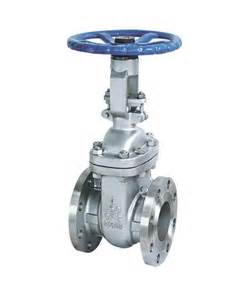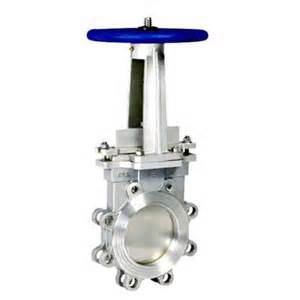Gate Valve
Gate valve, abbreviated as GV, is one of the most frequently used valve in piping systems and is classified as either "rising-stem" or "nonrising-stem" valves. The rising-stem gate valve has the stem attached to the gate, both gate and stem rise and lower together as the valve handwheel or actuator turns the stem. In the nonrising-stem gate valves the stem is threaded into the wedge, rising and lowering the wedge.
It is a multi turn valve which should be used for on and off service. If the valve is partially open as an attempt to throttle or control flow, turbulence from the stream could cause the wedge to vibrate and create a chattering noise. When fully opened, the gate valve creates minimal obstruction to the flow.
Gate valves control the process through the pipe with a gate. The gate might be wedge shaped or knife shaped, that slides up or down as the valve's handwheel is turned. As the handwheel is rotated, the gate slides through the valve body to block or release the flow.
Gate Valve Design Classification
Flap Gate Valve - They are installed at the end of a pipe to prevent back flow of debtis. When there is flow through a pipe the pressure will open the flap and will close when pressure is reduced or shut off. They can be opened manually or remotely, and they can be opened by the force of the flow or with a spring loaded or weighted flap. The purpose of a flap valve is to send water out of a flanged pipe while preventing debris such as sticks and leaves from flowing back in. The valve will open when direct pressure is applied to it, and it will close when that pressure is alleviated.
Knife Gate Valve - These are designed mainly for on/off and isolation services in systems with high content of suspended solids. They are used for handling pulp slurry and other fiberous materials which are extremely thick fluids or dry solids. The design of the blade allows it to cut through these materials and then clean itself as it is opened. The valves have a minimised pressure drop in fully open position, they are easy to actuate, they have a relatively low weight and are cost effective.
Slab Gate Valve - These valves are full port valves with a hole exactly the same size as the pipe. This design provides full flow through the valve and low pressure drop, and it allows for pigging the line when needed. Slab gate valves are used for the isolation of a process line in the chemical and petrochemical industries. They can be found at pump stations and along the lengths of pipelines, either buried or above ground. Slab gates are comprised of a single gate which raises to open, and lowers to close, between two seat rings.
Slide Gate Valve - Slide gates are used when a full bore flow, positive shut-off and low pressure is needed for material handling. Applications can include dry storage bins, silos and conveyors that handle dry bulk powders, pellets, and granules. Slide gate valves are linear motion valves in which a flat plate slides into the flow stream to provide a shut-off of material or air. The gate can close or open the slide plate on a moving column of material.
Wedge Gate Valve - Wedge gate are primarily designed to start or stop flow, and when a straight line flow of fluid and minimum flow restriction are needed. They can be used in most fluids such as air, gas, oil, steam and water for on/off or regulating service. They have a disk that retracts into the body when opened. When in service, these valves generally are either fully open or fully closed. Gate valves consists of three main parts, body, bonnet, and trim. The body is generally connected to other equipment by means of flanged, screwed or welded connections. The bonnet, which containing the moving parts, is attached to the body, usually with bolts, to permit maintenance. The valve trim consists of the stem, the gate, the disc or wedge and the seat rings.
- Flexible Wedge Gate Valve - By the addition of a groove or slot around its periphery, the flexible disc can adapt to temperature changes and adverse piping stresses without binding. The flexible design also is a little easier to manufacture in that minor imperfections in the seating surface angles can be compensated for by the disc’s flexibility.
- Solid Wedge Gate Valve - The solid wedge has been around the longest. The drawback to a solid design is that it does not have any flexibility and if there is any valve body/seat distortion due to extreme temperature fluctuations or pipe stresses, the solid disc can become jammed in the seats.
- Split Wedge/Parallel Disk Wedge Gate Valve - Consist of two discs with mating surfaces on the back side of each disc half then they are forced apart against parallel seats by a spring at the point of the closure. These mating surfaces allow the downward stem thrust to be uniformly transferred to the disc faces and onto the seats. This flexible design also provides protection against jamming due to thermal expansion. A disadvantage to the split design is that in dirty services, residue or debris can cake in between the disc halves, causing the valve to improperly seat or even jam.
Gate Valve Advantages and Disadvantages | |
|---|---|
| Advantages | Disadvantages |
|
|
Gate Valve DatasheetsFace to face dimensions for full and standard port valves is the same. All ball valves 2" and below are both standard and full port valves. |
|||
 |
|
 |
|

Tags: Valve Advantages and Disadvantages Design Classification

